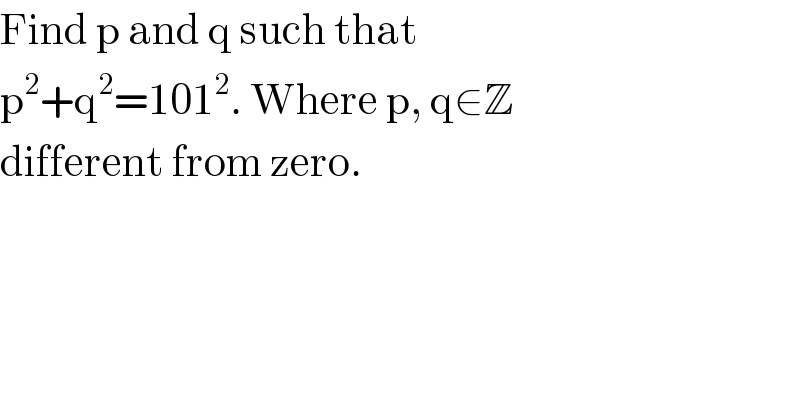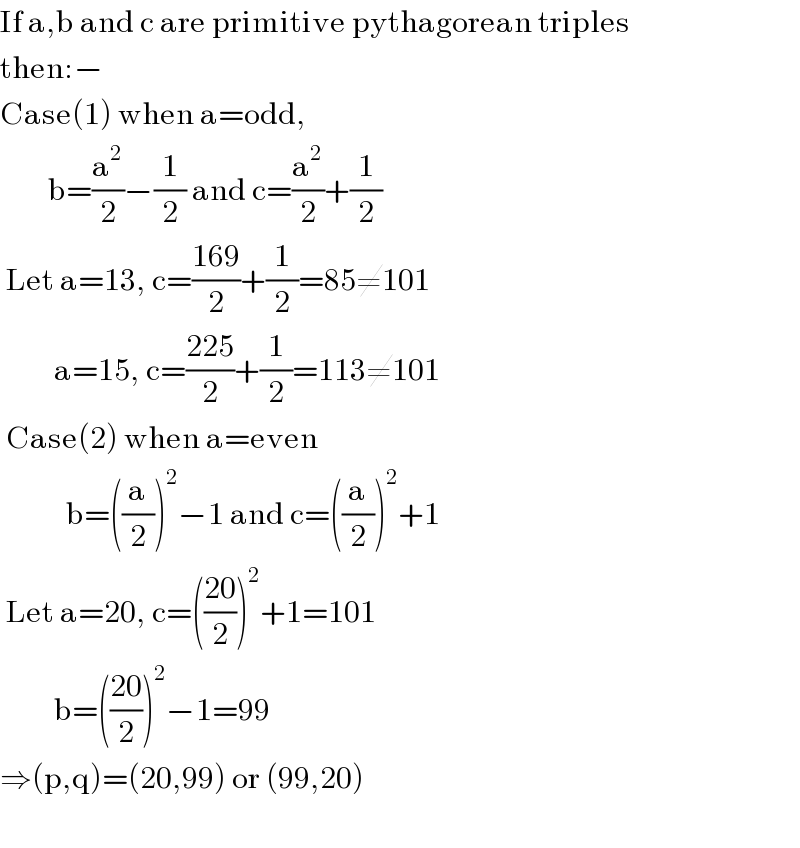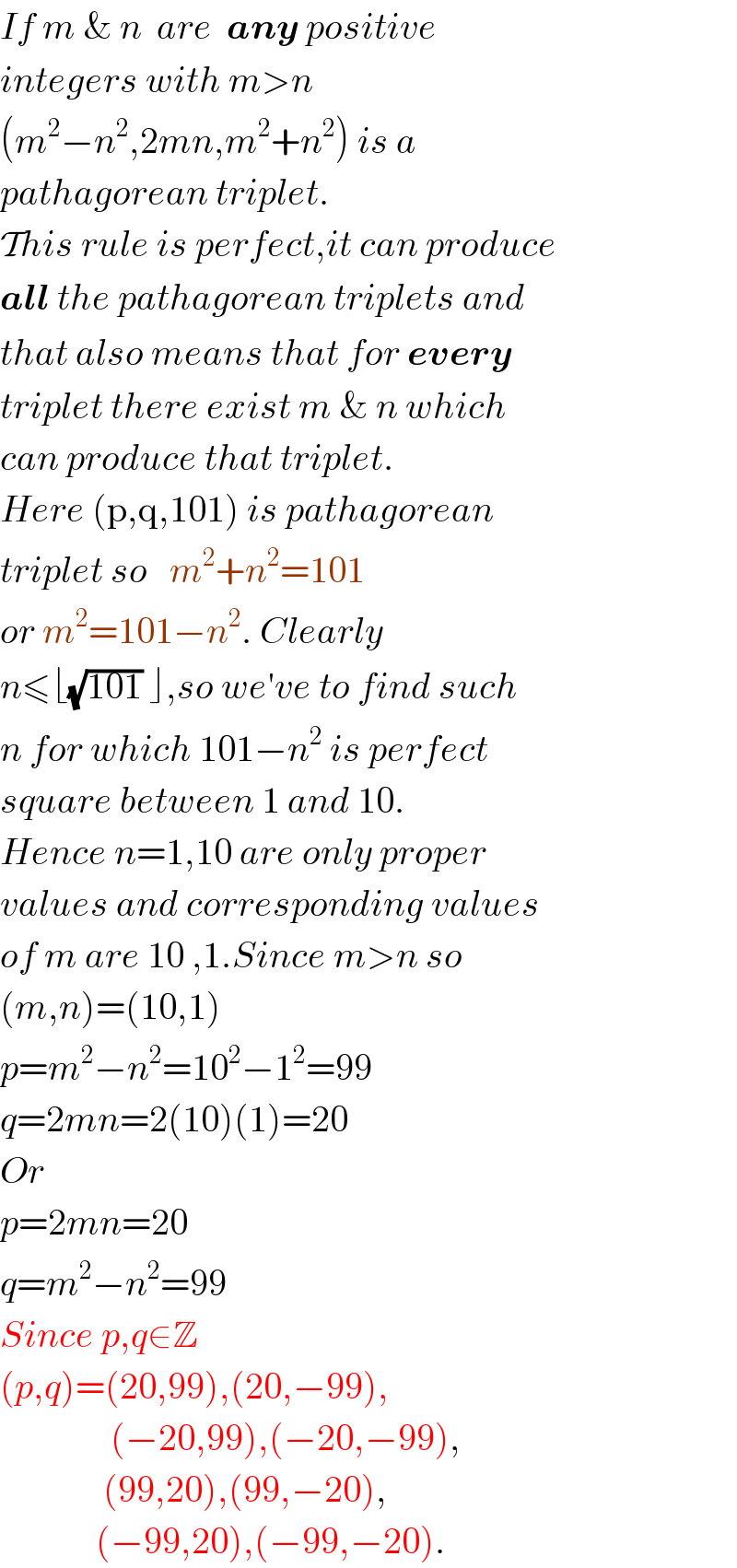
Question Number 113689 by Ar Brandon last updated on 14/Sep/20

$$\mathrm{Find}\:\mathrm{p}\:\mathrm{and}\:\mathrm{q}\:\mathrm{such}\:\mathrm{that} \\ $$$$\mathrm{p}^{\mathrm{2}} +\mathrm{q}^{\mathrm{2}} =\mathrm{101}^{\mathrm{2}} .\:\mathrm{Where}\:\mathrm{p},\:\mathrm{q}\in\mathbb{Z}\: \\ $$$$\mathrm{different}\:\mathrm{from}\:\mathrm{zero}. \\ $$
Commented by Rasheed.Sindhi last updated on 14/Sep/20

$${p}=\mathrm{20},{q}=\mathrm{99}\:{or}\:{p}=\mathrm{99},{q}=\mathrm{20} \\ $$
Answered by nimnim last updated on 14/Sep/20

$$\mathrm{If}\:\mathrm{a},\mathrm{b}\:\mathrm{and}\:\mathrm{c}\:\mathrm{are}\:\mathrm{primitive}\:\mathrm{pythagorean}\:\mathrm{triples} \\ $$$$\mathrm{then}:− \\ $$$$\mathrm{Case}\left(\mathrm{1}\right)\:\mathrm{when}\:\mathrm{a}=\mathrm{odd}, \\ $$$$\:\:\:\:\:\:\:\:\mathrm{b}=\frac{\mathrm{a}^{\mathrm{2}} }{\mathrm{2}}−\frac{\mathrm{1}}{\mathrm{2}}\:\mathrm{and}\:\mathrm{c}=\frac{\mathrm{a}^{\mathrm{2}} }{\mathrm{2}}+\frac{\mathrm{1}}{\mathrm{2}} \\ $$$$\:\mathrm{Let}\:\mathrm{a}=\mathrm{13},\:\mathrm{c}=\frac{\mathrm{169}}{\mathrm{2}}+\frac{\mathrm{1}}{\mathrm{2}}=\mathrm{85}\neq\mathrm{101} \\ $$$$\:\:\:\:\:\:\:\:\:\mathrm{a}=\mathrm{15},\:\mathrm{c}=\frac{\mathrm{225}}{\mathrm{2}}+\frac{\mathrm{1}}{\mathrm{2}}=\mathrm{113}\neq\mathrm{101} \\ $$$$\:\mathrm{Case}\left(\mathrm{2}\right)\:\mathrm{when}\:\mathrm{a}=\mathrm{even} \\ $$$$\:\:\:\:\:\:\:\:\:\:\:\mathrm{b}=\left(\frac{\mathrm{a}}{\mathrm{2}}\right)^{\mathrm{2}} −\mathrm{1}\:\mathrm{and}\:\mathrm{c}=\left(\frac{\mathrm{a}}{\mathrm{2}}\right)^{\mathrm{2}} +\mathrm{1} \\ $$$$\:\mathrm{Let}\:\mathrm{a}=\mathrm{20},\:\mathrm{c}=\left(\frac{\mathrm{20}}{\mathrm{2}}\right)^{\mathrm{2}} +\mathrm{1}=\mathrm{101} \\ $$$$\:\:\:\:\:\:\:\:\:\mathrm{b}=\left(\frac{\mathrm{20}}{\mathrm{2}}\right)^{\mathrm{2}} −\mathrm{1}=\mathrm{99} \\ $$$$\Rightarrow\left(\mathrm{p},\mathrm{q}\right)=\left(\mathrm{20},\mathrm{99}\right)\:\mathrm{or}\:\left(\mathrm{99},\mathrm{20}\right) \\ $$$$ \\ $$
Answered by Rasheed.Sindhi last updated on 15/Sep/20

$${If}\:{m}\:\&\:{n}\:\:{are}\:\:\boldsymbol{{any}}\:{positive} \\ $$$${integers}\:{with}\:{m}>{n} \\ $$$$\left({m}^{\mathrm{2}} −{n}^{\mathrm{2}} ,\mathrm{2}{mn},{m}^{\mathrm{2}} +{n}^{\mathrm{2}} \right)\:{is}\:{a} \\ $$$${pathagorean}\:{triplet}. \\ $$$$\mathcal{T}{his}\:{rule}\:{is}\:{perfect},{it}\:{can}\:{produce} \\ $$$$\boldsymbol{{all}}\:{the}\:{pathagorean}\:{triplets}\:{and} \\ $$$${that}\:{also}\:{means}\:{that}\:{for}\:\boldsymbol{{every}} \\ $$$${triplet}\:{there}\:{exist}\:{m}\:\&\:{n}\:{which} \\ $$$${can}\:{produce}\:{that}\:{triplet}. \\ $$$${Here}\:\left(\mathrm{p},\mathrm{q},\mathrm{101}\right)\:{is}\:{pathagorean} \\ $$$${triplet}\:{so}\:\:\:{m}^{\mathrm{2}} +{n}^{\mathrm{2}} =\mathrm{101} \\ $$$${or}\:{m}^{\mathrm{2}} =\mathrm{101}−{n}^{\mathrm{2}} .\:{Clearly} \\ $$$${n}\leqslant\lfloor\sqrt{\mathrm{101}}\:\rfloor,{so}\:{we}'{ve}\:{to}\:{find}\:{such} \\ $$$${n}\:{for}\:{which}\:\mathrm{101}−{n}^{\mathrm{2}} \:{is}\:{perfect} \\ $$$${square}\:{between}\:\mathrm{1}\:{and}\:\mathrm{10}. \\ $$$${Hence}\:{n}=\mathrm{1},\mathrm{10}\:{are}\:{only}\:{proper}\: \\ $$$${values}\:{and}\:{corresponding}\:{values} \\ $$$${of}\:{m}\:{are}\:\mathrm{10}\:,\mathrm{1}.{Since}\:{m}>{n}\:{so} \\ $$$$\left({m},{n}\right)=\left(\mathrm{10},\mathrm{1}\right) \\ $$$${p}={m}^{\mathrm{2}} −{n}^{\mathrm{2}} =\mathrm{10}^{\mathrm{2}} −\mathrm{1}^{\mathrm{2}} =\mathrm{99} \\ $$$${q}=\mathrm{2}{mn}=\mathrm{2}\left(\mathrm{10}\right)\left(\mathrm{1}\right)=\mathrm{20} \\ $$$${Or} \\ $$$${p}=\mathrm{2}{mn}=\mathrm{20} \\ $$$${q}={m}^{\mathrm{2}} −{n}^{\mathrm{2}} =\mathrm{99} \\ $$$${Since}\:{p},{q}\in\mathbb{Z} \\ $$$$\left({p},{q}\right)=\left(\mathrm{20},\mathrm{99}\right),\left(\mathrm{20},−\mathrm{99}\right), \\ $$$$\:\:\:\:\:\:\:\:\:\:\:\:\:\:\:\left(−\mathrm{20},\mathrm{99}\right),\left(−\mathrm{20},−\mathrm{99}\right), \\ $$$$\:\:\:\:\:\:\:\:\:\:\:\:\:\:\left(\mathrm{99},\mathrm{20}\right),\left(\mathrm{99},−\mathrm{20}\right), \\ $$$$\:\:\:\:\:\:\:\:\:\:\:\:\:\left(−\mathrm{99},\mathrm{20}\right),\left(−\mathrm{99},−\mathrm{20}\right). \\ $$
Answered by 1549442205PVT last updated on 16/Sep/20

$$\mathrm{We}\:\mathrm{known}\:\mathrm{that}\left(\:\mathrm{a},\mathrm{b},\mathrm{c}\:\right)\mathrm{is}\:\mathrm{a}\:\mathrm{triple}\:\mathrm{of}\: \\ $$$$\mathrm{Pythagor}\:\mathrm{posirive}\:\mathrm{integer}\:\mathrm{numbers}\: \\ $$$$\mathrm{where}\:\mathrm{b}^{\mathrm{2}} +\mathrm{c}^{\mathrm{2}} =\mathrm{a}^{\mathrm{2}} \\ $$$$\left(\mathrm{a},\mathrm{b}\right)=\mathrm{1if}\:\mathrm{and}\:\mathrm{only}\:\mathrm{if}\:\mathrm{c}=\mathrm{uv},\mathrm{b}=\frac{\mathrm{u}^{\mathrm{2}} −\mathrm{v}^{\mathrm{2}} }{\mathrm{2}}, \\ $$$$\mathrm{a}=\frac{\mathrm{u}^{\mathrm{2}} +\mathrm{v}^{\mathrm{2}} }{\mathrm{2}}\:\mathrm{where}\:\mathrm{u},\mathrm{v}\:\mathrm{are}\:\mathrm{odd}\:\mathrm{and}\:\mathrm{coprime} \\ $$$$.\mathrm{In}\:\mathrm{the}\:\mathrm{our}\:\mathrm{problem}\:\mathrm{p}^{\mathrm{2}} +\mathrm{q}^{\mathrm{2}} =\mathrm{101}^{\mathrm{2}} \left(\ast\right) \\ $$$$\mathrm{Since}\:\mathrm{101}\:\mathrm{is}\:\mathrm{a}\:\mathrm{prime},\mathrm{so}\:\left(\mathrm{p},\mathrm{q}\right)=\mathrm{1}. \\ $$$$\mathrm{Hence},\mathrm{p}=\mathrm{uv},\mathrm{q}=\frac{\mathrm{u}^{\mathrm{2}} −\mathrm{v}^{\mathrm{2}} }{\mathrm{2}},\frac{\mathrm{u}^{\mathrm{2}} +\mathrm{v}^{\mathrm{2}} }{\mathrm{2}}=\mathrm{101} \\ $$$$\Leftrightarrow\mathrm{u}^{\mathrm{2}} +\mathrm{v}^{\mathrm{2}} =\mathrm{202}\Rightarrow\mathrm{v}<\mathrm{9}<\mathrm{u}\leqslant\mathrm{13} \\ $$$$\left.\mathrm{i}\right)\mathrm{If}\:\mathrm{u}=\mathrm{13}\:\mathrm{then}\:\mathrm{v}^{\mathrm{2}} =\mathrm{202}−\mathrm{169}=\mathrm{33}\Rightarrow\mathrm{rejected} \\ $$$$\left.\mathrm{ii}\right)\mathrm{If}\:\mathrm{u}=\mathrm{11}\:\mathrm{then}\:\mathrm{v}^{\mathrm{2}} =\mathrm{202}−\mathrm{121}=\mathrm{81}=\mathrm{9}^{\mathrm{2}} \\ $$$$\Rightarrow\mathrm{v}=\mathrm{9}\Rightarrow\mathrm{p}=\mathrm{uv}=\mathrm{99},\mathrm{q}=\frac{\mathrm{11}^{\mathrm{2}} −\mathrm{9}^{\mathrm{2}} }{\mathrm{2}}=\mathrm{20} \\ $$$$\mathrm{Since}\:\mathrm{p},\mathrm{q}\:\:\mathrm{have}\:\:\mathrm{equal}\:\mathrm{role}\:\mathrm{in}\:\mathrm{the} \\ $$$$\mathrm{equation},\mathrm{we}\:\mathrm{obtain}\: \\ $$$$\left(\boldsymbol{\mathrm{p}},\boldsymbol{\mathrm{q}}\right)\in\left\{\left(\mathrm{99},\mathrm{20}\right),\left(\mathrm{20},\mathrm{99}\right).\mathrm{From}\:\mathrm{this}\right. \\ $$$$\mathrm{follows}\:\left(−\mathrm{p},\mathrm{q}\right),\left(\mathrm{p},−\mathrm{q}\right),\left(−\mathrm{p},−\mathrm{q}\right) \\ $$$$\mathrm{also}\:\mathrm{satisfying} \\ $$$$\boldsymbol{\mathrm{second}}\:\boldsymbol{\mathrm{way}}: \\ $$$$\mathrm{If}\left(\mathrm{p},\mathrm{q}\right)\mathrm{is}\:\mathrm{a}\:\mathrm{root}\:\mathrm{of}\:\left(\ast\right)\:\mathrm{then}\:\left(−\mathrm{p},\mathrm{q}\right),\left(\mathrm{p},−\mathrm{q}\right) \\ $$$$\mathrm{and}\:\left(−\mathrm{p},−\mathrm{q}\right)\mathrm{are}\:\mathrm{also}\:\mathrm{roots}\:\mathrm{of}\:\left(\ast\right).\mathrm{Hence} \\ $$$$\mathrm{we}\:\mathrm{just}\:\mathrm{need}\:\mathrm{find}\:\mathrm{pairs}\:\left(\mathrm{p},\mathrm{q}\right)\mathrm{of}\:\mathrm{positive} \\ $$$$\mathrm{integer}\:\mathrm{numbers}\:\mathrm{of}\:\mathrm{the}\:\mathrm{equation}\left(\ast\right) \\ $$$$\mathrm{Since}\:\mathrm{101}\:\mathrm{is}\:\mathrm{a}\:\mathrm{prime}\:\mathrm{number},\mathrm{p}\:\mathrm{and}\:\mathrm{q} \\ $$$$\mathrm{are}\:\mathrm{coprime}\left(\:\mathrm{because}\:\mathrm{suppose}\:\mathrm{that}\:\right. \\ $$$$\mathrm{gcd}\left(\mathrm{p},\mathrm{q}\right)=\mathrm{d}\neq\mathrm{1}\:\mathrm{then}\:\mathrm{p}=\mathrm{md},\mathrm{q}=\mathrm{nd}\:\mathrm{with} \\ $$$$\left(\mathrm{m},\mathrm{n}\right)=\mathrm{1}.\mathrm{Then}\:\mathrm{p}^{\mathrm{2}} +\mathrm{q}^{\mathrm{2}} =\mathrm{101}^{\mathrm{2}} \left(\ast\right) \\ $$$$\Leftrightarrow\left(\mathrm{m}^{\mathrm{2}} +\mathrm{n}^{\mathrm{2}} \right)\mathrm{d}^{\mathrm{2}} =\mathrm{101}^{\mathrm{2}} \Rightarrow\mathrm{101}\vdots\mathrm{d}\:\mathrm{which}\:\mathrm{is} \\ $$$$\left.\mathrm{contradiction}\:\mathrm{to}\:\mathrm{the}\:\mathrm{fact}\:\mathrm{that}\:\mathrm{101}\:\mathrm{is}\:\mathrm{prime}\right) \\ $$$$.\mathrm{Furthermore},\mathrm{among}\:\mathrm{two}\:\mathrm{numbers}\:\mathrm{p},\mathrm{q} \\ $$$$\mathrm{must}\:\mathrm{have}\:\mathrm{one}\:\mathrm{number}\:\mathrm{is}\:\mathrm{even}\:\mathrm{and}\:\mathrm{other} \\ $$$$\mathrm{number}\:\mathrm{is}\:\mathrm{odd}.\mathrm{Hence},\mathrm{WLOG}\:\mathrm{suppose} \\ $$$$\mathrm{p}\:\mathrm{is}\:\mathrm{odd}\:\mathrm{and}\:\mathrm{q}\:\mathrm{is}\:\mathrm{even}.\mathrm{From}\:\mathrm{that}\:\mathrm{we}\:\mathrm{have} \\ $$$$\:\left(\ast\right)\Leftrightarrow\mathrm{p}^{\mathrm{2}} =\left(\mathrm{101}+\mathrm{q}\right)\left(\mathrm{101}−\mathrm{q}\right) \\ $$$$\mathrm{Put}\:\mathrm{101}+\mathrm{q}=\mathrm{m},\mathrm{101}−\mathrm{q}=\mathrm{n}\:\Rightarrow\mathrm{m}>\mathrm{n},\mathrm{we} \\ $$$$\mathrm{get}\:\mathrm{p}^{\mathrm{2}} =\mathrm{mn},\mathrm{q}=\frac{\mathrm{m}−\mathrm{n}}{\mathrm{2}},\mathrm{101}=\frac{\mathrm{m}+\mathrm{n}}{\mathrm{2}}. \\ $$$$\mathrm{We}\:\mathrm{see}\:\mathrm{that}\:\mathrm{m}\:\mathrm{and}\:\mathrm{n}\:−\mathrm{coprime}. \\ $$$$\mathrm{because}\:\mathrm{of}\:\mathrm{suppose}\:\mathrm{the}\:\mathrm{contrary},\:\mathrm{that} \\ $$$$\mathrm{gcd}\left(\mathrm{m},\mathrm{n}\right)=\mathrm{d}\neq\mathrm{1}.\mathrm{Then}\:\mathrm{m}=\mathrm{m}_{\mathrm{1}} \mathrm{d},\mathrm{n}=\mathrm{n}_{\mathrm{1}} \mathrm{d} \\ $$$$\mathrm{From}\:\mathrm{that}\:\mathrm{101}=\frac{\mathrm{m}+\mathrm{n}}{\mathrm{2}}=\frac{\mathrm{m}_{\mathrm{1}} +\mathrm{n}_{\mathrm{1}} }{\mathrm{2}}\mathrm{d} \\ $$$$\mathrm{which}\:\:\mathrm{is}\:\mathrm{impossible}\:\mathrm{since}\:\mathrm{101}\:\mathrm{is}\:\mathrm{prime} \\ $$$$\mathrm{Therefore}\:,\mathrm{m}\:\mathrm{and}\:\mathrm{n}\:\mathrm{are}\:\mathrm{coprime}.\mathrm{From} \\ $$$$\mathrm{p}^{\mathrm{2}} =\mathrm{mn}\:\mathrm{and}\:\left(\mathrm{m},\mathrm{n}\right)=\mathrm{1}\:\mathrm{we}\:\mathrm{infer}\: \\ $$$$\mathrm{m}=\mathrm{u}^{\mathrm{2}} ,\mathrm{n}=\mathrm{v}^{\mathrm{2}} \mathrm{where}\:\mathrm{u}\:\mathrm{and}\:\mathrm{v}−\mathrm{coprime}, \\ $$$$\mathrm{u}>\mathrm{v}\:>\mathrm{0}\:\mathrm{and}\:\mathrm{are}\:\mathrm{odd}\:\mathrm{numbers}.\mathrm{Finally}, \\ $$$$\mathrm{we}\:\mathrm{obtain}\:\begin{cases}{\mathrm{p}=\mathrm{uv}\left(\mathrm{1}\right)}\\{\mathrm{q}=\frac{\mathrm{u}^{\mathrm{2}} −\mathrm{v}^{\mathrm{2}} }{\mathrm{2}}\left(\mathrm{2}\right)}\\{\mathrm{101}=\frac{\mathrm{u}^{\mathrm{2}} +\mathrm{v}^{\mathrm{2}} }{\mathrm{2}}\left(\mathrm{3}\right)}\end{cases} \\ $$$$\left(\mathrm{3}\right)\Leftrightarrow\mathrm{u}^{\mathrm{2}} +\mathrm{v}^{\mathrm{2}} =\mathrm{202}\Rightarrow\mathrm{v}<\mathrm{11}\leqslant\mathrm{u}\leqslant\mathrm{13} \\ $$$$\left.\mathrm{i}\right)\mathrm{For}\:\mathrm{u}=\mathrm{13}\Rightarrow\mathrm{v}^{\mathrm{2}} =\mathrm{202}−\mathrm{169}=\mathrm{33}\Rightarrow\nexists\mathrm{v}\in\mathbb{Z} \\ $$$$\left.\mathrm{ii}\right)\mathrm{For}\:\mathrm{u}=\mathrm{11}\Rightarrow\mathrm{v}^{\mathrm{2}} =\mathrm{202}−\mathrm{121}=\mathrm{81} \\ $$$$\Rightarrow\mathrm{v}=\mathrm{9}.\mathrm{Put}\:\mathrm{into}\:\left(\mathrm{1}\right)\left(\mathrm{2}\right)\:\mathrm{we}\:\mathrm{get} \\ $$$$\left(\mathrm{p},\mathrm{q}\right)\in\left(\mathrm{99},\mathrm{20}\right)\mathrm{and}\:\mathrm{due}\:\mathrm{to}\:\mathrm{above}\:\mathrm{note}\:\mathrm{and}\:\mathrm{the} \\ $$$$\mathrm{equality}\:\mathrm{of}\:\mathrm{p}\:\mathrm{and}\:\mathrm{q}\:\mathrm{in}\:\mathrm{equation}\:\mathrm{we}\:\mathrm{get} \\ $$$$\left(\mathrm{p},\mathrm{q}\right)\in\left\{\mathrm{99},\mathrm{20}\right),\left(−\mathrm{99},\mathrm{20}\right),\left(\mathrm{20},\mathrm{99}\right),\left(\mathrm{20},−\mathrm{99}\right), \\ $$$$\left.\left(\mathrm{99},−\mathrm{20}\right),\left(−\mathrm{99},−\mathrm{20}\right),\left(−\mathrm{20},\mathrm{99}\right),\left(−\mathrm{20},−\mathrm{99}\right)\right\} \\ $$
